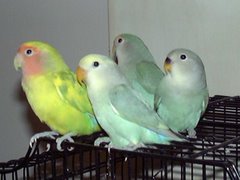
If you know your
lovebirds well, you will be able to tell by their behavior and appearance whether or not they are feeling well.
Healthy lovebirds are
active and
feathers are
flat and
sleek.
Deviant behavior could include that there is some kind of problem, may be
lovebird sickness.The lovebird might start to become withdrawn, apathetic, start making stereotypical movements, start plucking its feathers or just generally becomes restless. One of the first signs of sickness is that the lovebird’s feathers are “fluffed up” rather than flat and sleek and that the bird is generally listless.
A lot of lovebirds will look like this when the ambient temperature is too low for them. By fluffing up their feathers they retain some body heat in the space between their feathers. An increase in temperature will generally improve things in these cases.
Other symptoms that tell you that there may be something wrong with lovebirds includes difficulty in breathing, “gasping” for air, diarrhea, loss of appetite, bald spots, feather loss, abundant molting, tum-ors on the bill, legs, and around the eyes, partial or full paralysis, a discharge from the nose or eyes, and swellings.
When you suspect sickness with your birds, you should never just wait and see how things develop, but take immediate action. If you keep in touch with experienced bird-keepers and breeders, then you will be able to present the problem to them.
Experienced bird-keepers know certain symptoms very well and often know exactly how you treat them. You could try and get in touch with experienced people via bird associations. In addition, you could try and contact your veterinary surgeon.
A simple examination of the lovebird’s droppings might be all that is needed to find out what is wrong. In other cases, a blood sample or examination of one of the affected birds be needed to find out what is wrong.









 Free Ads For Bloggers
Free Ads For Bloggers

